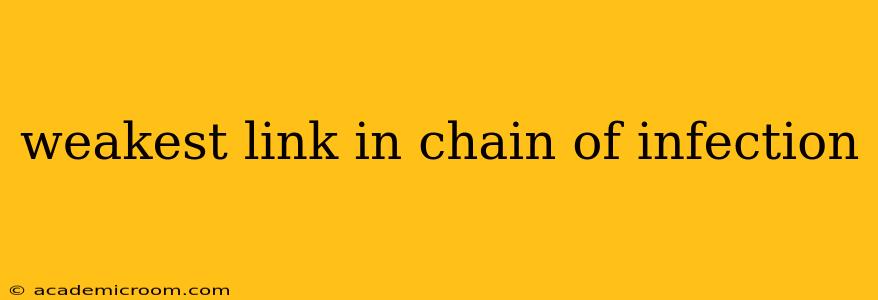The chain of infection is a model used to understand how infectious diseases spread. It illustrates the crucial steps involved, from the pathogen's origin to the establishment of infection in a new host. Understanding this chain allows us to identify the weakest link—the point where intervention is most effective in preventing disease transmission. While each link is vital, focusing on the weakest link offers the most impactful strategy for disease control. This often depends on the specific disease and context, but generally, several links present prime opportunities for interruption.
What are the Links in the Chain of Infection?
Before we identify the weakest link, let's review the components of the chain:
- Infectious Agent: The pathogen itself—bacteria, virus, fungus, or parasite—capable of causing disease.
- Reservoir: The place where the pathogen lives and multiplies. This could be a human, animal, or environment.
- Portal of Exit: The pathway by which the pathogen leaves the reservoir. Examples include the respiratory tract (coughing, sneezing), gastrointestinal tract (feces), or wounds.
- Mode of Transmission: How the pathogen travels from the reservoir to the new host. This can be direct contact, indirect contact (through fomites), airborne, vector-borne (mosquitoes, ticks), or fecal-oral.
- Portal of Entry: The way the pathogen enters the new host. This often mirrors the portal of exit; for example, inhalation, ingestion, or contact with broken skin.
- Susceptible Host: An individual who is vulnerable to infection due to factors like age, immune status, or underlying health conditions.
Which Link is the Weakest? It Depends…
Pinpointing the single weakest link is difficult, as it varies depending on the specific infectious agent and circumstances. However, several links often represent particularly vulnerable points for intervention:
1. Mode of Transmission: A Frequently Vulnerable Link
Breaking the chain at the mode of transmission is often highly effective. This involves strategies like:
- Hand hygiene: Simple handwashing dramatically reduces the spread of many pathogens transmitted through direct or indirect contact.
- Isolation and quarantine: Preventing contact between infected individuals and susceptible hosts.
- Vector control: Eliminating or reducing the populations of disease-carrying insects (mosquitoes, ticks, etc.).
- Safe food handling practices: Preventing contamination of food and water sources.
- Proper disposal of waste: Preventing environmental contamination.
2. Portal of Exit and Portal of Entry: Targets for Prevention
Controlling portals of exit and entry is crucial. This includes:
- Cough etiquette: Covering coughs and sneezes prevents airborne transmission.
- Wound care: Proper cleaning and dressing of wounds prevents pathogen exit and entry.
- Safe sex practices: Prevents transmission of sexually transmitted infections.
3. Susceptible Host: Building Resistance
Strengthening the host's defenses is a crucial but often underappreciated link. This involves:
- Vaccination: Building immunity to specific pathogens.
- Improved nutrition and sanitation: Enhancing overall health and resistance to infection.
- Access to healthcare: Early diagnosis and treatment prevent disease progression and spread.
What about the Reservoir?
While eliminating the reservoir (e.g., eradicating a disease from a specific animal population) is ideal, it's often the most challenging link to break. This is particularly true for zoonotic diseases (diseases that jump from animals to humans).
Conclusion: A Multi-pronged Approach
There isn't one single "weakest link." Effective infection control relies on a multi-pronged approach, targeting multiple links in the chain simultaneously. The most effective strategy will depend on the specific disease and the context. By understanding the chain of infection and focusing efforts on the most vulnerable points for intervention, we can significantly reduce the transmission of infectious diseases and protect public health.
